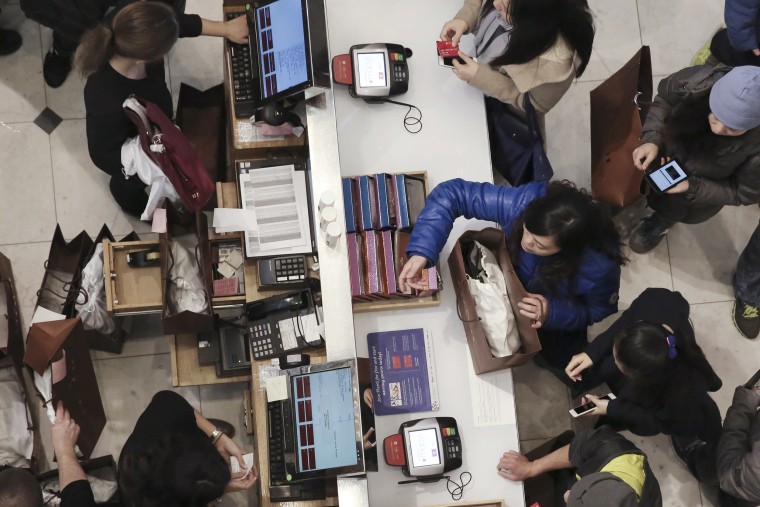Thanksgiving should mark the start of a festive season, but the millions working this weekend have precious little to celebrate. For many of the working-poor, the big feast isn’t the turkey dinner at home, but the feeding frenzy of the Black Friday sales floor at dawn — a day replete with shopping revelry for consumers but, for workers, one more slog in another workweek without respite from everyday hardship.
This year, however, the holidays might treat some workers slightly more kindly: A 2016 Bloomberg BNA workplace survey found that about 80 percent of workers were granted two paid days off for the Thanksgiving holiday, up from 70 percent the three years prior. It's a tepid improvement, but it could signal that, after decade of boom-bust economic cycles, both our consumption patterns and workplace practices might finally be starting to cool down.
Still, many workers won't have anything close to a leisurely holiday season: Low-wage laborers in stores and restaurants are most likely to be serving you on your day off. In contrast to typical white-collar and manufacturing workers, according to a recent CareerBuilder survey, roughly half of workers in the retail, hospitality and leisure sectors are working on Thanksgiving.
Big Box retail’s wide bottom rung — the lowest-paying, least stable retail jobs like cashiers and sales — intersects with other social gaps: Black and Latino workers and women are concentrated in marginal part-time positions, typically with fewer promotional opportunities. And although women workers are driving growth in low-wage retail jobs today, they're uniquely vulnerable on the job, exposed not just to economic insecurity, but also to everyday gender bias and, sometimes, outright abuse.
Activists have, for instance, denounced Walmart over complaints of systemic labor violations going back years, including allegations of discriminatory pay scales for women, sexual harassment, and the denial of basic rights like taking time off for pregnancy or childbirth. Workers are punished when they protest.

Workers in large businesses with 1,000 or more employees — like Walmart — are also four times more likely than small businesses to make some workers work on Thanksgiving. But those workers staffing your local Big Box this weekend might not be on duty as part of a regular full-time schedule; they may instead have picked up an extra holiday shift to cover this month’s bills. Often, low-wage employees rely on added peak-season shifts because the rest of the year is filled with low-paying irregular gigs or part-time shifts. This leaves many workers scrambling at year’s end to cobble together enough work hours to make rent, stave off debt and if they’re blessed, have a little extra to splurge on their kids’ gifts.
So if you find yourself queueing in the Walmart parking lot on Friday morning, mind the store associates corralling the teeming mobs; this holiday season might be an especially tough slog for them, since the company recently “streamlined” its store operations by rolling back its extra holiday pay policy.
The megachain has also moved to cut back staff and closing stores nationwide in order to stay “competitive” in a retail market increasingly dominated by online outlets. But labor advocates warn that slashing labor costs might deprive thousands of workers’ a modest year-end boost and force them to stretch already-meager paychecks, or to take on additional shifts — a good deal for Walmart’s low-price empire at the expense of workers’ households.
Sadly, the low-wage, high-stress labor structure has become standard across today’s retail and service workforces. At many businesses, the 40-hour week simply doesn’t exist any more: Staffers work on “on call” hours, or pick up part-time temp jobs with no benefits (not even weekends off). Just one in five low-wage workers get paid vacation time, and just 15 percent of the lowest-paid workers can take paid sick days; so a holiday — or just a day to nurse a child at home with the flu — means a day without pay.
About one-sixth of workers are stuck on unstable shift schedules, so their boss controls their work hours and could change workers’ shifts with just a few days notice. The mix of erratic work hours and poverty wages wreaks havoc on working families: Labor researchers have linked schedule volatility to constant income instability, hindering workers from maintaining mortgage payments, saving for college, or covering childcare fees — and forget about stocking stuffers.
The low-wage, high-stress labor structure has become standard across today’s retail and service workforces.
Meanwhile, the Trump administration has moved to kill an Obama-era rule to raise overtime pay for millions of workers, promising an even rougher holiday season next year.
And, recent structural shifts in the low-wage economy could soon push the poorest workers out of work altogether. Though the low-wage chainstore model has expanded aggressively across the country in recent years, now superstores are consolidating as brick-and-mortar outlets lose market share to digital retailers. The communities where Walmart has taken over the local economy and crowded out mom-and-pop shops over the years might soon lose their main source of jobs as megastores shutter and lay off workers.
Any slight uptick in the rate of workers getting a break this Thanksgiving hardly offsets the day-to-day drudgery of low-wage work. But one ray of hope is that a change in seasonal workplace practices may reflect a political climate shift, spurred by rising grassroots campaigns for fair wages and decent workplaces.
The Fight for $15 campaign for a living wage and union rights has mobilized waves of workers nationwide in fast food restaurants, retail and other precarious sectors. The momentum has spun off into campaigns demanding more comprehensive labor reforms to make work schedules more equitable. Fair workweek legislation has emerged in various communities, starting with San Francisco’s pioneering Retail Bill of Rights, which provides for fairer pay scales and paid sick days, while giving part-time workers priority in hiring for full-time positions and mandating advanced notice of scheduling changes. New York and Seattle are on trend with similar fair workweek policies for service workers.
These changes are good for business, too; Advocates point out that offering staff steady, less punishing schedules and decent wages can curb turnover rates and boost workforce productivity.
Economic forecasters have predicted the “death of retail,” noting the mass closures of megamalls and Big Box chains. But perhaps it's actually only the death of a certain kind of retail; maybe it’s just the implosion of the precarious jobs that feed into a system of dead-end, low-end labor. The retail jobs that will survive might just be those that strike a sustainable balance between quality service and quality jobs.
This is the season of thankless work for many of us, but it’s also a time for resolutions: Worker-led movements are hustling to transform the low-wage economy into an economy that supports families and communities together. That would make the holidays a more generous time for all.
Michelle Chen is a contributing writer at The Nation, a contributing editor at Dissent and a co-producer of the “Belabored” podcast and Asia Pacific Forum on WBAI FM. She tweets at @meeshellchen.

